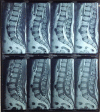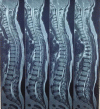Cauda Equina Syndrome in a Military Personnel: A Case Report
- PMID: 37464857
- PMCID: PMC10276935
- DOI: 10.31729/jnma.8173
Cauda Equina Syndrome in a Military Personnel: A Case Report
Abstract
Cauda equina syndrome is a rare but severe neuro-spinal disorder commonly caused due to lumbar disc herniation, which occurs mostly at lower levels of L4-S1. We report a case of 38-year-old male soldier deployed on a foreign mission who presented to a level 1 military hospital 4 months back with complaints of decreased movement of bilateral lower limbs and severe low back pain radiating to the right lower limb for 2 hours. He was referred to a higher centre and diagnosed with cauda equina syndrome due to massive disc herniation at levels L2-L3. He underwent laminotomy and discectomy of the extruded intervertebral disc after 48 hours. On subsequent follow-up, his bladder and lower limbs sensations were normal however, he had bowel incontinence, hypotonia, hyporeflexia, and no significant improvement in power. Hence, early diagnosis, referral, and timely intervention affect the outcomes in a cauda equina syndrome patient.
Keywords: case reports; cauda equina syndrome; disc herniation; low back pain; military personnel.
Conflict of interest statement
Figures
Similar articles
-
Cauda Equina Syndrome Due to Lumbar Disc Herniation: a Review of Literature.Folia Med (Plovdiv). 2017 Dec 20;59(4):377-386. doi: 10.1515/folmed-2017-0038. Folia Med (Plovdiv). 2017. PMID: 29341941 Review.
-
Red Flag for Cauda Equina Syndrome in Symptomatic Lumbar Disc Herniation.World Neurosurg. 2020 Nov;143:232-234. doi: 10.1016/j.wneu.2020.07.200. Epub 2020 Aug 3. World Neurosurg. 2020. PMID: 32758658 No abstract available.
-
Cauda equina schwannoma with concomitant intervertebral disc herniation: A case report and review of literature.J Clin Neurosci. 2019 Apr;62:229-231. doi: 10.1016/j.jocn.2018.12.033. Epub 2019 Jan 9. J Clin Neurosci. 2019. PMID: 30638784 Review.
-
Percutaneous Endoscopic Lumbar Discectomy as an Emergent Surgery for Cauda Equina Syndrome Caused by Lumbar Disc Herniation.Pain Physician. 2020 Jun;23(3):E259-E264. Pain Physician. 2020. PMID: 32517401
-
Lumbar Disc Herniation Causing Cauda Equina Syndrome in a Paediatric Patient. A Case Report.Ortop Traumatol Rehabil. 2016 Aug 30;18(4):389-392. doi: 10.5604/15093492.1220830. Ortop Traumatol Rehabil. 2016. PMID: 28102171
References
Publication types
MeSH terms
LinkOut - more resources
Full Text Sources
Medical


